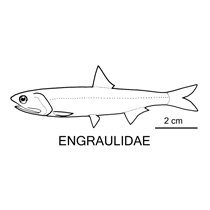- Classification
- ACTINOPTERYGII
- CLUPEIFORMES
- ENGRAULIDAE
-
Fish Classification
-
Class
ACTINOPTERYGII Ray-finned fishes -
Order
CLUPEIFORMES Herrings -
Family
ENGRAULIDAE Anchovies
Family ENGRAULIDAE
Small silvery, herring-like fishes with a conical snout extending beyond the lower jaw, a large mouth reaching well beyond the eye, a single short-based dorsal fin at about mid-body, pectoral fins low on the sides, pelvic fins abdominal, originating before or below the dorsal-fin base, a forked tail and a wide silvery stripe along the mid-sides. The body is covered in smooth, often weakly attached scales.
More Info
|
Family Taxonomy |
The Engraulidae include more than 145 species in 16 genera worldwide. In Australia, 23 species in six genera have been recorded. |
|
Family Distribution |
Widespread in tropical to cold temperate seas worldwide. Most species inhabit shallow water marine waters, although some can ascend rivers and a few are purely freshwater. |
|
Family Description |
Most species have a characteristic long snout over a subterminal mouth which extends far behind the level of the eye. Some species have striking posterior extensions to the upper jaw and one non-Australian species has photophores. Most Indo-Pacific species have scutes on the belly. The body is usually elongate and variously compressed. |
|
Family Size |
Maximum size for the family is about 300 mm. |
|
Family Colour |
Most species have a characteristic silver stripe along the side. |
|
Family Feeding |
Anchovies feed by opening their mouths wide to filter plankton from the water column with their numerous elongate gill rakers. |
|
Family Reproduction |
The sexes are separate and fertilisation is external. Anchovies produce pelagic eggs and the larvae are pelagic. |
|
Family Commercial |
Anchovies are commercially important in most areas of the world including Australia, where relatively small numbers are marketed. |
|
Author |
Dianne J. Bray & John R. Paxton |
References
Hildebrand, S.F. (1963). Family Engraulidae. in Olsen, Y.H. (ed.) Fishes of the western North Atlantic. Mem. Sears Fndn. Mar. Res. 1(3): 152–249 figs 25–59
Nelson, G.J. (1970). The hypobranchial apparatus of teleostean fishes of the families Engraulidae and Chirocentridae. Am. Mus. Novit. 2410: 1–30 figs 1–11
Nelson, J.S. (1994). Fishes of the World. New York : John Wiley & Sons 3rd Edn 600 pp.
Whitehead, P.J.P. (1973). A synopsis of the clupeoid fishes of India. J. Mar. Biol. Ass. India 14(1): 160–256 figs 1–68
Whitehead, P.J.P., Boeseman, M. & Wheeler, A.C. (1966). The types of Bleeker's Indo-Pacific elopoid and clupeoid fishes. Zool. Verh. 84: 1–159 pls 1–19
Whitehead, P.J.P., Nelson, G.J., & Wongratana, T. (1988). FAO species catalogue. Clupeoid fishes of the world (Suborder Clupeoidei). An annotated and illustrated catalogue of the herrings, sardines, pilchards, sprats, anchovies and wolf-herrings. Part 2. Engraulididae. FAO Fish. Synop., No. 125, volume 1, part 2 pp. 305–579
Wongratana, T., Munroe, T.A. & Nizinski, M.S. (1999). Family Engraulidae. pp. 1698–1753 in Carpenter, K.E. & Niem, V.H. (eds) The Living Marine Resources of the Western Central Pacific. FAO Species Identification Guide for Fisheries Purposes. Rome : FAO Vol. 3 pp. 1397–2068
















































